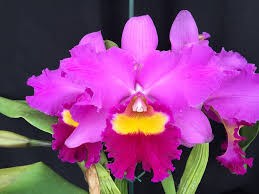The last two weeks were articles about orchids. This week, the orchid we are featuring is the Cattleya orchid. This is the orchid that comes to mind for most people when they envision an orchid. They are large orchids that come in many vibrant colours, are often scented and are not too difficult to grow. As with any plant, it is important to give the plant the best possible chance to thrive by providing the best cultural conditions.
Cattleyas or Catts need abundant though not intense light in order to grow and flower well. They need 2,000 to 3,000 foot-candles of light and the early morning sun is significant. Never put orchids in direct, strong sunlight as they will very quickly show their dissatisfaction. If you are growing under grow lights, then T-5 fluorescents or L.E.D. lights are the best choice for providing artificial light.
A day-time temperature between 70 and 80 degrees Fahrenheit (21 to 27 degrees Celsius) will keep them happy and for the night, there should be at least a 10 degree drop in the temperature. This lower nighttime temperature will help to initiate flower buds and provide stronger growth. This mimics what they would experience in their natural surroundings which are the tropical regions of Central and South America, largely from Venezuela, Brazil and Colombia. Panama is the northern limit of the South American species.
Thinking of where these orchids come from, humidity is important. They prefer to have a relative humidity between 45 and 60 per cent, which is much higher than what we generally experience here! Filling a saucer with crushed rock and some water beneath your Catts will help to elevate the humidity right around the plant. However, ensure that the pot is not sitting in water.
If you grow a variety of orchid types, then you will see that your Catts require less water than the Phals and Paphs. In fact, only water your Catts when the media is dry almost to the bottom of the pot. Generally, this means watering around once a week. If you are unsure if your Catts need water, then do not water but wait a couple more days before watering. Water that is distilled or free of a lot of additives as much of our water is treated to ensure it meets potable safety standards.
When your Catts bloom, they will grace your home for a period of three to six weeks. If you are lucky enough to have a fragrant Catt, then that sweet scent will remind you of another aspect of their beauty and just another reason to grow orchids! When your Catt is getting ready to bloom, give it a bit more frequent watering than usual.
As far as feeding your orchids, they do need to be given a dilute solution of fertilizer that is complete – or contains all the micronutrients every 2 to 3 weeks. You can purchase specialty fertilizers for orchids but if you are a thriftier grower then using what you have on hand might be just as suitable but needs to be in a more dilute form.
Potting media is generally a mixture of larger diameter fir bark, leica pellets and sphagnum moss. The media should reflect the cultural customs and watering schedule. I repot all my orchids after they flower.
Hanbidge is the Lead Horticulturist with Orchid Horticulture. Find us at www.orchidhort.com; by email at [email protected]; on facebook @orchidhort and on instagram at #orchidhort. Tune into GROW Live on our Facebook page https://www.facebook.com/orchidhort or check out the Youtube channel GROW https://www.youtube.com/channel/UCzkiUpkvyv2e2HCQlFl0JyQ?




